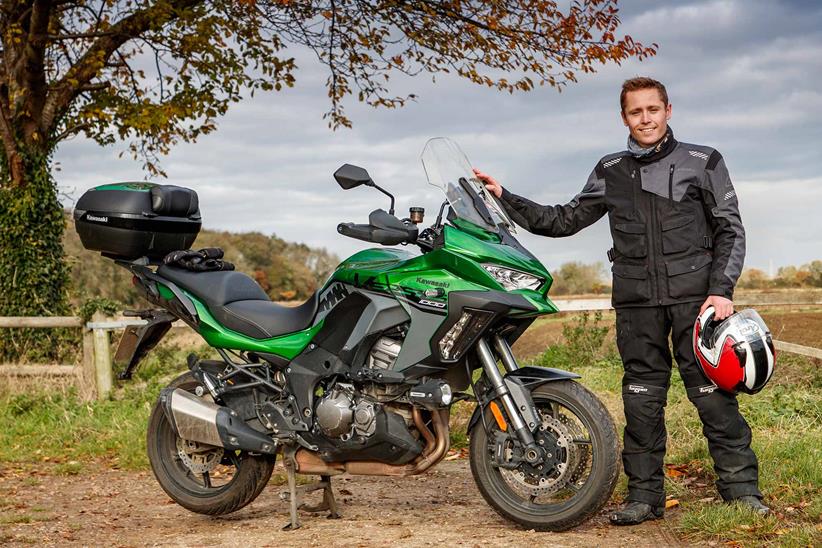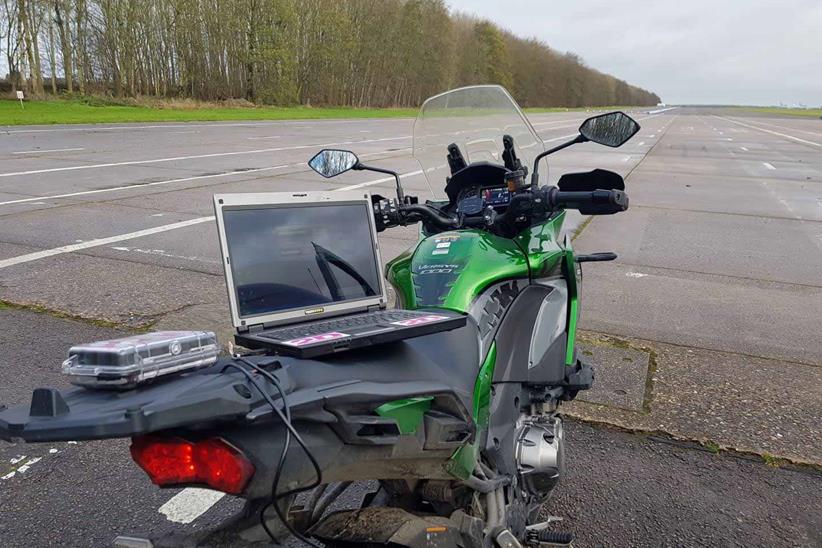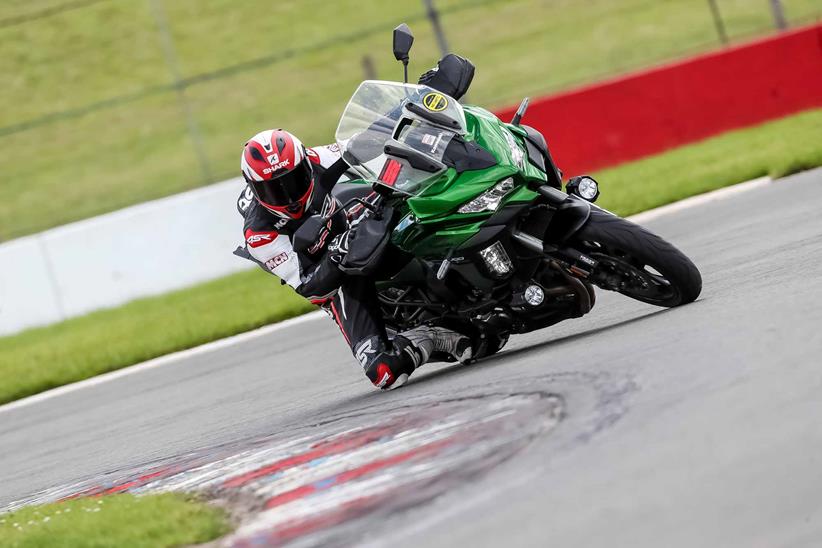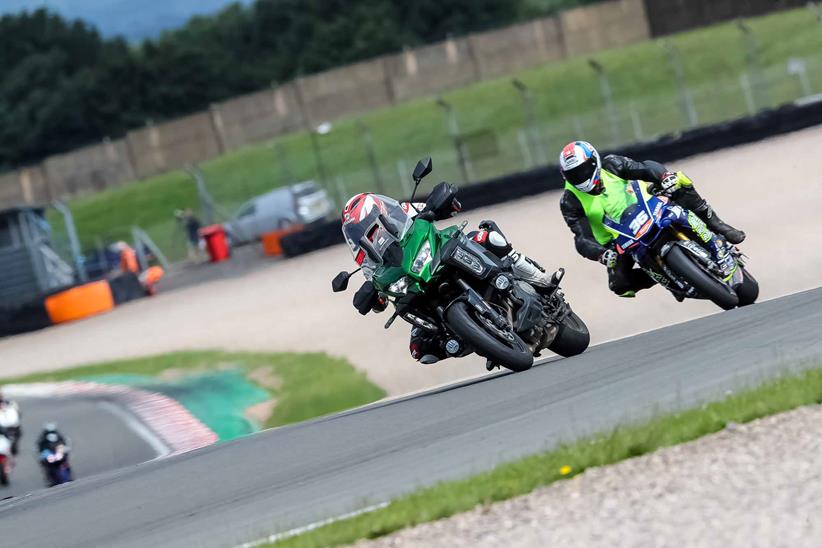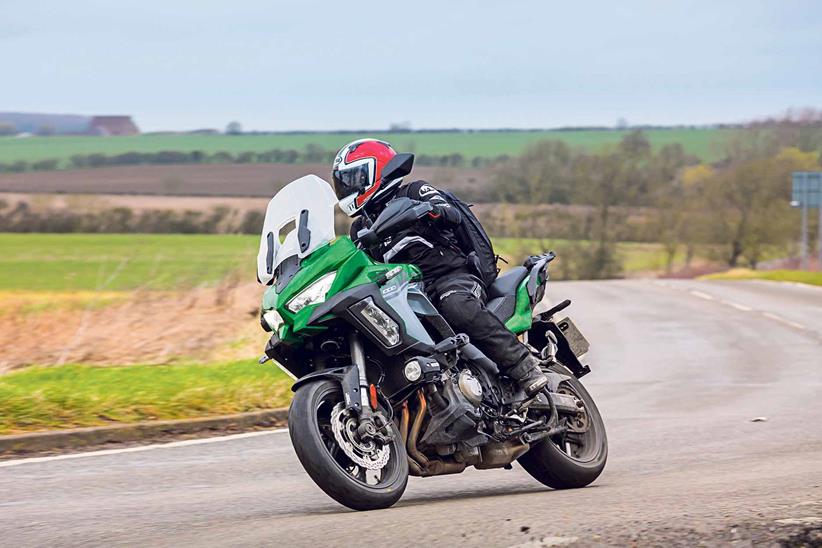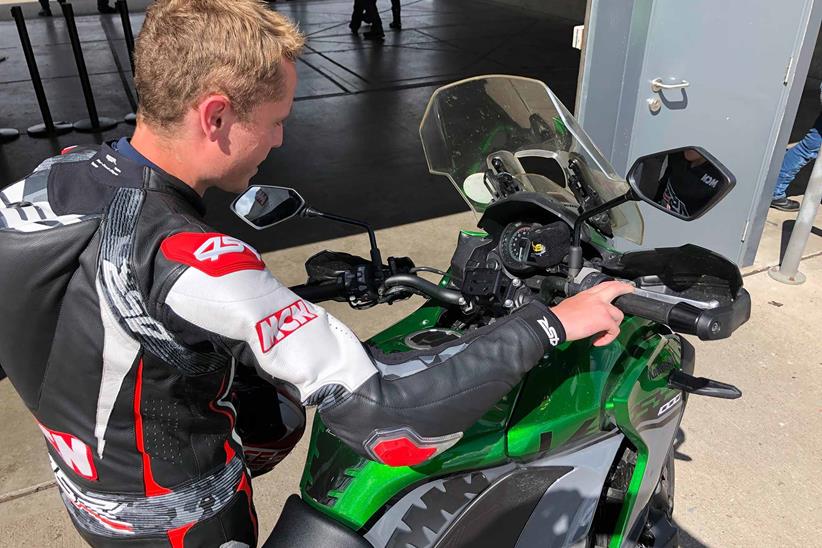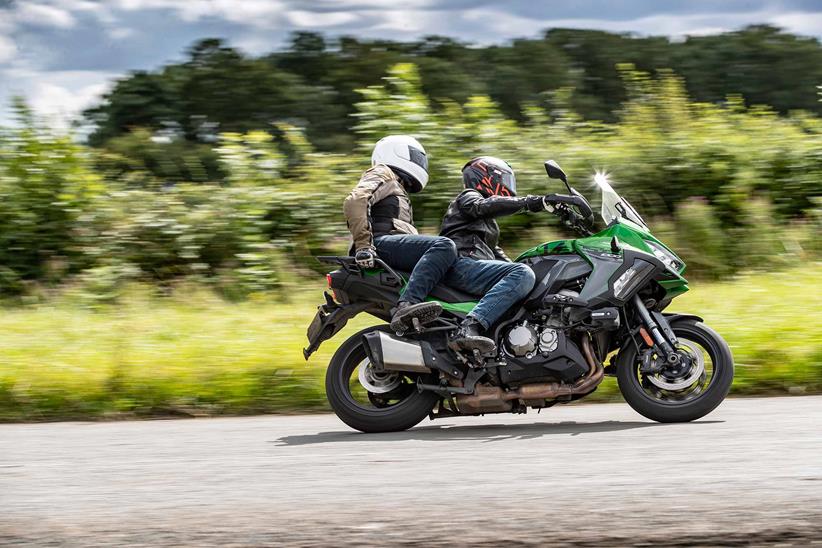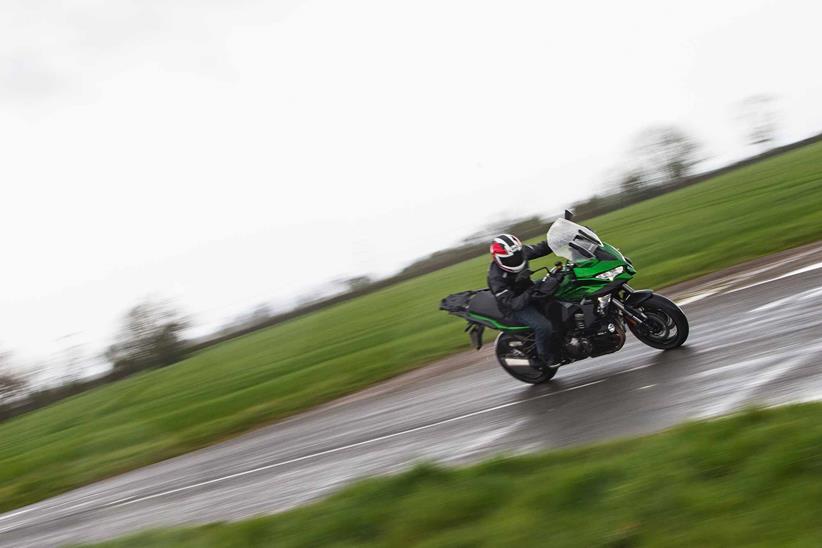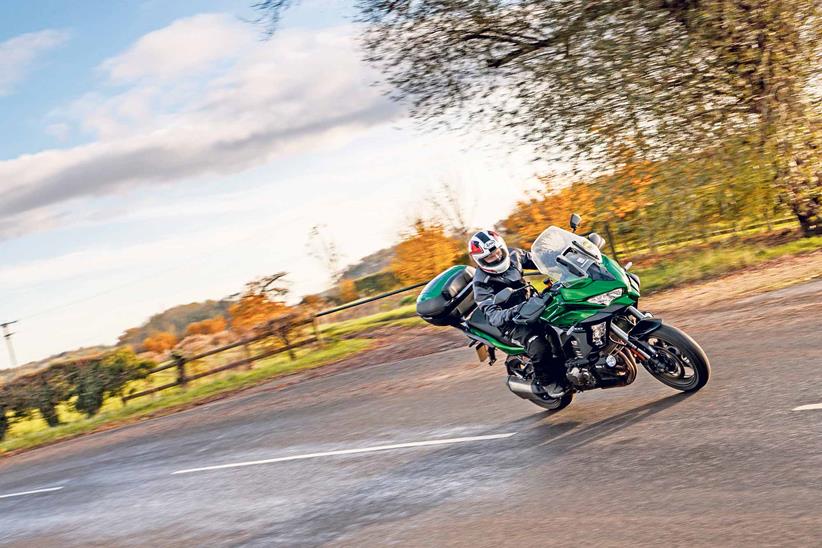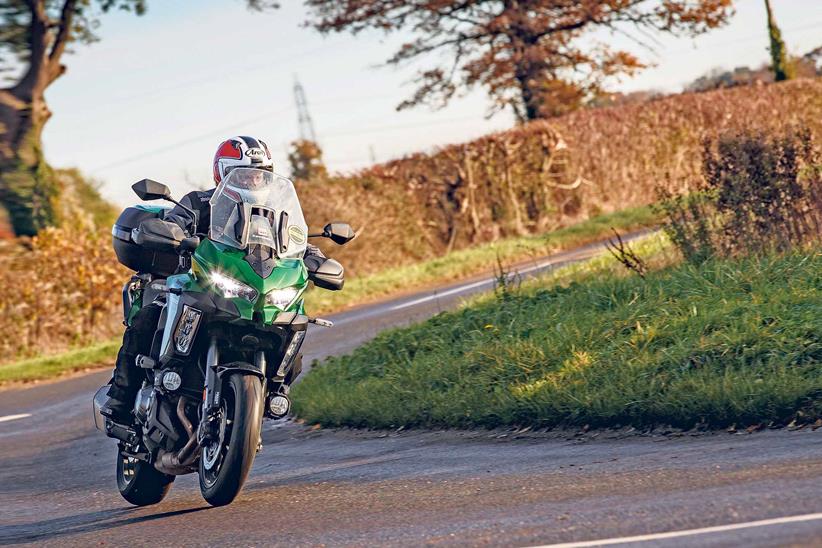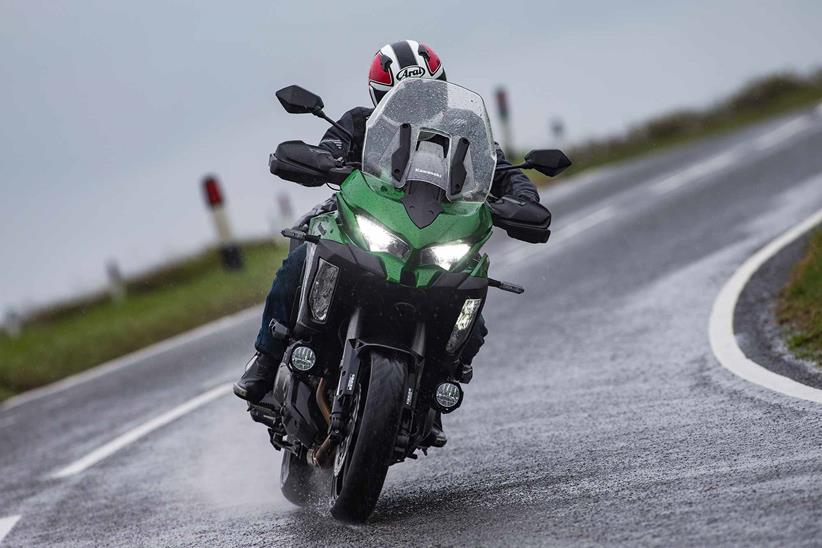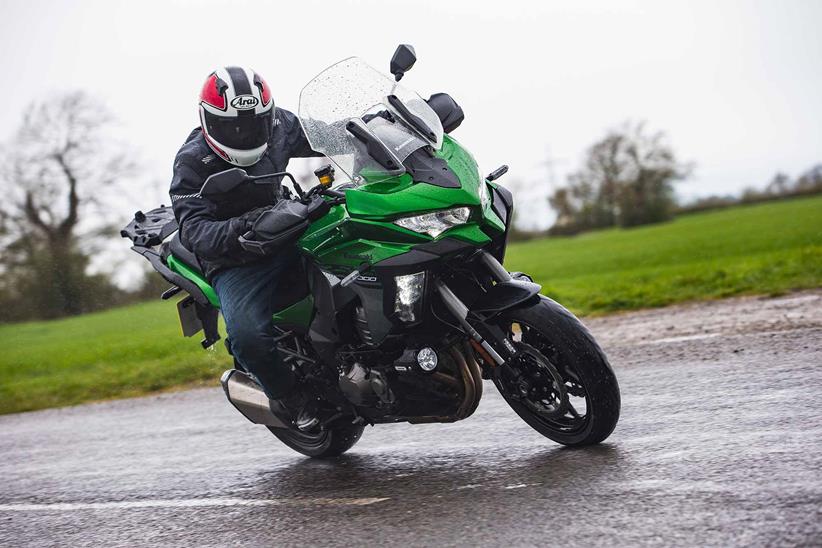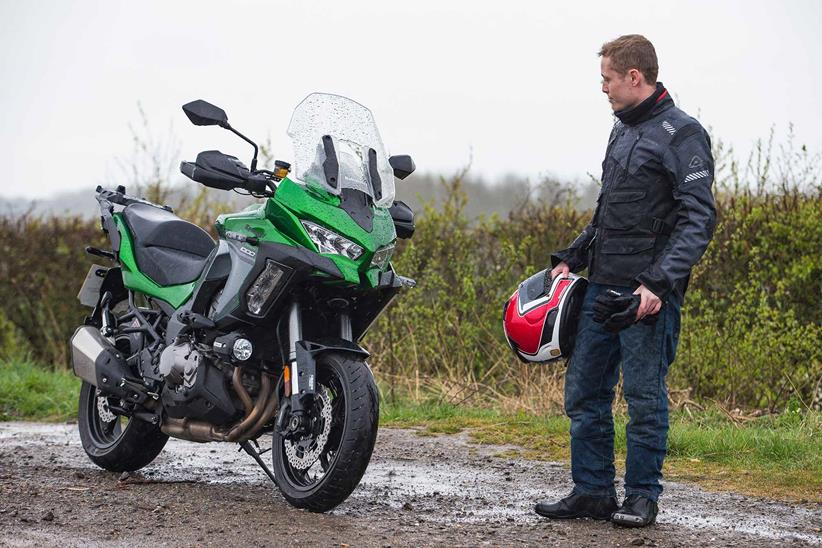MCN Fleet: Waving goodbye to Kawasaki’s Green Giant
‘Christ this thing’s big… I’m not sure what I’ve got myself in for here,’ is what I told myself as I wobbled out of the MCN carpark for the first-time aboard Kawasaki’s Versys 1000 SE almost a year ago today.
A 1043cc inline-four-cylinder sports adventure bike weighing in at 257kg and shod with comfort-centric electronically adjustable Showa springs, compared with the lightweight sportsbikes I had grown up with, it felt as alien as was possible to achieve.
Producing 118bhp from its Euro4-friendly engine (it’s now Euro5), the SE is Kawasaki’s top-spec Versys; featuring a glitzy TFT screen complete with mobile connectivity, an up and down quickshifter, self-healing paint and more.
A built-in Inertial Measurement Unit (IMU) also gets you a full suite of electronic aids, including conventional and cornering ABS, and traction control. There are also riding modes and a ride-by-wire throttle facilitates cruise control.
It was without doubt the largest and most tech-laden motorcycle I had ever lived with long-term and after 16,000 miles of all-weather duties, I am giving back the keys far more impressed than I could have ever imagined. Agile, smooth and sublimely comfortable, it’s been a largely reliable workhorse that could show most sportsbikes a clean pair of heels along your average English country backroad.
![]()
Physical size
With a seat height of 840mm as standard and equipped with a flat, wide 21-litre fuel tank upfront, the Kawasaki can be an intimidating proposition for shorter riders. At 5ft 6in, I am no exception, with the quarter-tonne beast initially proving stressful to manoeuvre at slow speeds – taking around 600 miles before I could confidently hold it on one foot.
Once on the move, it becomes less oppressive though, with an easy reach to the bars and pegs, as well as plenty of wiggle room in the seat, should you need to adjust your position on the move. After a few weeks, moving such a large machine became second nature and a year later, I have experienced no embarrassing tumbles or low-speed spills. Phew.
That said, if it was to start falling, there is no way I would be physically able to save it, making crash protection a must-have accessory.
Divisive looks
It took me a long old time to warm to the looks of the big Versys and I’m not sure I will ever come to love them. Part of Kawasaki’s latest wave of styling, the Ninja and H2-inspired snub-nosed front end is by no means beautiful and the whole thing lacks the emotive wow factor of an equivalent Ducati Multistrada or KTM Super Duke GT.
You can remedy this slightly by removing some of the practicality though. By undoing the four screws that hold the top box bracket in place, the whole unit can be removed – nicking off around six inches off the bike’s overall length and making it look slightly more sporty.
That said, after a year of ownership, there were parts of the Kawasaki’s look that I came to really enjoy. Take the self-healing paint for instance; when washed on a sunny day, the metallic flecks glint majestically like no other motorcycle and once finished, you can’t help but stand back, grab a brew and admire the sparkly finish.
Fantastic engine
Look up the definition of smooth in the dictionary and a picture of Kawasaki’s 1043cc inline-four will be there.
Complete with a rumbly induction note under hard acceleration and a gentle burble at a constant speed, it’s a long-distance rider’s dream; producing little to no vibes through the bars or pegs anywhere in the rev range and sitting comfortably between 4000rpm and 5000rpm at motorway speeds for some sophisticated and relaxed high-speed progress making. What’s more, regularly producing a respectable 51.3mpg, it’s more than capable of going more than 200 miles between fill-ups.
It’s not all about motorways though and along your favourite B-road, the flexible engine is your best friend, with enough meat in the middle to run a serious turn of pace without screaming its nuts off and an up-and-down quickshifter to flick through the cogs with precision.
Faults explored
Drinking no oil or coolant between its 7500-mile service intervals, the Versys has been relatively fuss-free. That said, in August the bike started refusing to change into either third or fifth anywhere above 6000rpm when using the quickshifter.
Initially a small issue, it became a frustrating daily occurrence and it was returned to Kawasaki for a month of fettling. Although no cause was ever officially confirmed, they replaced a couple of gears, along with the quickshifter and sensor.
Alongside quickshifter woes, the bike also took a stone through the radiator, which is left exposed thanks to its long-legged suspension. Fired up from the rear wheel of the Kawasaki Z900RS I was pursuing, replacing the unit at an official Kawasaki dealership cost an eye-watering £755.20 and could have been avoided by installing an optional Kawasaki cover for just £79.95.
![]()
Distance comfort
With a well-padded pillion and rider’s seat, which compliments the advanced suspension, as well as a tall screen, chunky handguards and wide flat tank, which hide you from the elements in all conditions, the Kawasaki offers sublime levels of comfort.
Free from buffeting and escaping most of the cold winter air, you can travel serious distances with little or no fatigue. That said, this can turn the Versys into an absolute oven in the summer time, restricting your ability to get cooling air on the move.
Handling
With wide bars to push on and grippy standard Bridgestones underneath you, the Kawasaki feels incredibly planted mid-corner and after our first proper ride together I was left staggered at its capabilities.
Reaching a dashboard-indicated 49 degrees of lean in the peak of summertime grippiness, there’s enough two-up comfort for a week around Europe, alongside ample ground clearance and poise for some serious weekend scratching and even a trackday.
Kawasaki Versys 1000 SE: The story so far
- Update 1: An introduction
- Update 2: Taming the ‘Green Giant’
- Update 3: The big Versys can really shift
- Update 4: Your questions answered
- Update 5: Leaky radiator spoils the fun
- Update 6: Trackday at Donington Park
- Update 7: 7500-mile update
- Update 8: Pillion comfort
- Update 9: 10,000-mile update
- Update 10: How fast does the Versys go?
- Update 11: Quickshifter issues halt progress
- Update 12: Tyre testing
Update 12: 15,000 miles of tyre testing on the Kawasaki Versys 1000 SE
Published: 24.02.20
![]()
The tyres you fit to your bike are incredibly important. By affecting the ride, handling and grip they’re fundamental to the enjoyment you derive from every ride and finding the right set of rubber can transform the feel of your bike.
As an ‘adventure-sport’, the Kawasaki Versys 1000 SE has conventional 17in rims, meaning you’re spoilt for road-friendly options when it comes to renewal time. And after around 15,000 miles, the big Kwak is now on its fourth set of rubber, each with their own draws and drawbacks. But which impressed the most?
Bridgestone Battlax T31, £258.83*
![]()
The Versys 1000 SE comes equipped with Bridgestone’s Battlax T31s. Lasting around 5500 miles before they squared-off rear was running dangerously close to the wear indicators, they inspired confidence from the outset, with ample grip in the wet and plenty in the dry when it came to some serious backroad carving.
But although impressing, I was convinced that there was potential for greater cornering prowess, without sacrificing wet weather confidence…
Dunlop SportSmart Mk3, £272.76*
![]()
Step forward Dunlop’s SportSmart Mk3. Launched April last year, they arrived on the scene just in time, promising plenty of bite in wet and dry, which Dunlop claimed lasted right down to the wear blocks.
With a steeper profile than the Bridgestones, they allowed the Versys to tip into corners faster and inspired greater cornering confidence, carrying me through over 5000 miles of commutes, weekend rides and even a trackday! Due to the minimalist tread pattern I was initially sceptical at their ability in the wet, however, they remained stable in all but the most torrential conditions.
Avon Spirit ST, £230.15*
![]()
With the onset of cold weather towards the end of October and the Dunlops starting to square noticeably, I opted to install a set of Avon Spirit STs. As the cheapest pair in this list and with an attractive, banana-shaped tread pattern and gentle profile, they seemed ideal for the worsening conditions.
It was also a chance to try something different, instead of gravitating towards the usual Pirelli and Metzeler. Unfortunately, however, life with the Avons proved a struggle. Although looking great and OK in the dry, on damp roads below 10°C they struggled for grip, sometimes breaking traction in a straight line under acceleration and occasionally slipping mid-corner.
Although I never felt out of control they made me more reluctant to lean into a corner. Warmer conditions could’ve told a different story, though.
Vredestein Centauro ST £n/a
![]()
Despite still having plenty of life left, after 2000 miles the Avons were removed to make way for a set of Vredestein Centauro STs, as the Versys was chosen as the guinea pig for a test of the first set in the UK. As they’re the company’s first bike tyre, UK distribution is still being sorted so no prices are yet available.
But for a first effort they’re seriously impressive. In just under 1000 miles, they’ve reinvigorated my love for the Versys, inspiring me to lean into bends and wind on the throttle without any scares. With a flat touring profile, they tip-in slower than the likes of the Dunlops but hold a line well, once into the bend.
*Prices from sportsbikeshop.co.uk
Update 11: Green giant blots its copybook with a quickshifter issue
Published: 09.01.20
![]()
For the last eight months, I have marvelled at the Kawasaki Versys 1000 SE’s seemingly faultless reliability, continually carrying me across the country in refined, silky-smooth comfort, despite daily use in all weathers for both pleasure and commuting.
Unfortunately, this streak of stress-free riding came to an end in late August, after it became apparent that the bike had developed a fault with its quickshifter, with it refusing to change into either third or fifth anywhere above 6000rpm.
Not wanting to risk causing damage to its internals, I sent the bike back to Kawasaki for them to see if they could diagnose the problem.
And despite having the bike for around a month, they were unable to reach a definitive root cause, saying: “We investigated the problem that you reported and were unable to find anything that was defective but did note some gear change issues when giving it a fairly harsh road test.”
Not disclosing what constitutes a “fairly harsh road test”, they added: “Therefore, as a matter of course, we stripped and inspected the gearbox and replaced a couple of damaged gears, along with the quickshifter and sensor. There is a possibility that some of the damage was as a result of our testing.”
![]()
Since the bike has returned, the problem has gone – which suggests that changing some parts has cured it. When questioned whether the issue would be covered under warranty, Kawasaki added: “When an issue is reported that can be clearly attributed to a defective part, a warranty repair is undertaken at no cost to the owner.
“No clear defect was discovered during our investigation, or during a normal road test. We then put the bike through a pretty extreme test, which reproduced the reported symptom, but in doing so may have contributed to the internal damage that was discovered during the subsequent engine inspection.
“Had a customer reported to a dealer that quick shifting was problematic and no clear cause was identified or reproduced, we would not advise they carry out the kind of test we did.”
Update 10: Just how fast is the Kawasaki Versys 1000 SE?
Published: 19.12.19
![]()
Weighing in at 257kg and producing a claimed 118bhp from its Z1000-derived 1043cc inline-four-cylinder engine, I have always been impressed at the Kawasaki Versys 1000 SE’s surprising turn of pace.
With enough drive in the midrange to make mincemeat of overtakes and plenty of poke up-top to shine on a racetrack, I have long wondered just how fast the Versys actually goes.
To find out, I enlisted the services of MCN’s resident data-logger, Bruce Dunn, who has been professionally speed testing motorcycles for over 20 years. Having ridden everything from the Ducati Desmosedici RR (as seen below), to Allen Millyard’s bonkers V10 Viper motorbike (on which he achieved 207.101mph), he was the perfect pilot for such a task.
Stripped of luggage and with the screen on its lowest setting, the location for such a test was the two-mile straight at Bruntingthorpe, Leicestershire, on a crisp morning in early December.
Achieving a GPS-logged 0-60mph time of 3.93 seconds, the SE continued on to 133.76mph in a time of 37.16 seconds – despite the speedo actually reading 139mph.
Interestingly, 130mph was achieved in 28.10 seconds, with the final 3.76mph taking an additional 9.06 seconds and an extra 535.01 metres of tarmac. Also impressive was the 0-100mph time, which was achieved in a respectable 8.81 seconds – just 0.24 seconds than Honda’s sporty middleweight CBR650R, tested by Bruce back in August. This is despite the Kawasaki weighing a whole 50kg more.
Speaking about the run, Bruce said: “The performance was what I expected for a bike of this size. It’s smooth all-round and it feels refined. There’s no jarring from it under acceleration and it doesn’t get unsettled.
“The quickshifter was fine and helped it to feel smooth. It’s also got a really good feel from the clutch, which modulates power very well.
“Stability from zero to max speed produced no measurable instability – even in the early stages, where the front wheel is going light. It doesn’t want to shake the bars, either.”
Alongside acceleration and top speed testing, Bruce also recorded 70-0mph braking test. Covering a distance of 55.94 metres, it took 3.89 seconds to come to a standstill – something which impressed our man.
“There’s really good feel and power from the brakes,” he said. “You could argue that it’s a bit soft, but they are good enough to get the best out of them.”
![]()
Update nine: 10,000 miles of Versy-tility
Published: 07.11.19
![]()
It’s hard to believe I’ve been testing the mammoth Versys 1000 SE since early April, tackling the back end of winter, a summer of weekend blasts, thousands of commuting miles in all weathers and even a trackday.
With every new challenge, my admiration for the bike has increased; capable of hours of continuous comfort when you need it, as well as boasting bags of backroad ability when you fancy a good scratch. It’s good on fuel, gives a smooth power delivery, and would be the ideal companion for cross-continental epics. However, it hasn’t all been plain sailing. This is the story of our first 10,000 miles together.
600 miles
Being just 5ft6in tall, early rides on the Versys felt quite daunting. With the bike weighing 257kg wet and with a standard seat height of 840mm, early stops and slow speed manoeuvres were negotiated with gritted teeth.
Although equipped with an optional low seat, which makes it slightly narrower and removes 20mm, it took around a week of riding before I could confidently hold the bike on one foot.
2000 miles
Removing the bike’s luggage and switching to ‘sport mode’ reveals the Versys to be a surprisingly sharp backroad blaster. With a crisp, predictable throttle response and firm, but forgiving suspension, muscling the big Kwak around a bend is effortless, its mass allowing you to carry plenty of mid-corner pace.
4800 miles
Following months of ultra-reliable usage, the bike was victim to a stone through the radiator during a group ride, covering my right leg, boot and both tyres in sweet-smelling coolant.
Replacing the radiator at an official Kawasaki dealership was £755.20 – which could’ve been avoided by fitting an optional Kawasaki radiator guard priced at £79.95.
![]()
5500 miles
The rear OE Bridgestone T31 tyre had completely squared and was running close to the wear indicators. With summertime on the horizon, I opted to fit a set of Dunlop SportSmart Mk3 tyres, which proved perfect; offering consistent, dependable grip in all conditions (until their replacement at 10,700 miles). The sportier profile also allowed the bike to tip into corner more quickly and offered far greater feedback.
7300 miles
Inspired by the Versys’ surprising cornering prowess, I headed to Donington Park for a trackday. Using the 2.49-mile GP layout, the SE carried me through six sessions of hysterical, knee-dragging fun on just one tank of fuel, with 21 miles of range still remaining.
Although running out of ground clearance around Melbourne and Goddards, on its firmest suspension setting in ‘sport’, the Versys proved to be far more engaging and enjoyable on circuit than I could have ever imagined it would.
A short trip to the shops for some food transformed into a 30-mile twisty ride! With weather as nice as this, it would’ve been rude not to. #MCNFleet19 #ride5000miles pic.twitter.com/hktVjnX1L2
— Dan Sutherland (@DanielJS46) October 18, 2019
8000 miles
Over time, it has become apparent that the bike struggles with a wobbly screen. Adjusted manually via two screws, these fasteners have loosened themselves on multiple occasions, allowing the screen to rise on the move and obscure my vision, often at a wonky angle.
10,000 miles
With autumn upon us, my evening commute is now done almost entirely at night. This has caused issues with operating the complex bar- mounted switchgear, with a lack of back-lit buttons, meaning you often press the wrong thing. A problem amplified by winter gloves.
160 miles later and the #MCNFleet19 #Versys1000SE is home from a trip to @Kawasaki_News HQ! With such a big screen, comfy seat and cruise control, the motorway-laden trip proved an absolute doddle. Who else has been riding today? pic.twitter.com/QfsiiGBdUT
— Motor Cycle News (@MCNnews) September 25, 2019
Update eight: Kawasaki’s Versys 1000 SE is perfection for pillions
Published: 04.09.19
![]()
One of my favourite aspects of riding a motorcycle on the road is taking a pillion passenger, and with the Kawasaki Versys 1000 SE that couldn’t be easier.
A chance to share the journey, as well as sharpen your riding skills, it’s at its most enjoyable when taking someone who has never experienced two wheels; giving you the unique opportunity to inspire a new biker at the same time.
Using an electronic Showa suspension system, derived from the ZX-10R SE and tweaked for touring duties, altering the Versys’ springs for pillions can be done in seconds, either through the dash or via the ‘Rideology’ app.
With three riding modes to set the base level of damping, as well as three rear preload options, the damping can be fine-tuned within the bike’s settings, allowing you to create the perfect pillion package.
Despite no dedicated solo rider and pillion settings, I’ve found the ideal combination to be the ‘Rider with Passenger and Luggage’ preload option and the ‘Sport’ riding mode for maximum poke. Load can be tweaked, dependant on your pillion’s size and weight.
Once underway, the damping is adjusted every millisecond to suit variables like road speed, throttle position, lean angle and suspension movement, thanks to inbuilt stroke sensors within the forks and shock.
The result is a serene riding experience that, if sorted correctly, allows you to ride in almost exactly the same manner as you would solo. The electronic support also improves a pillion’s experience, delivering maximum comfort.
This opinion was concurred by my brother, Matt, who has been ‘fortunate’ enough to go pillion with me on bikes of most genres.
After a recent 120-mile two-up jaunt, he said: “It’s one of the most comfortable bikes I’ve been on. It’s more pillion friendly than most and offers good back support from the curved seat and padded top box.”
![]()
Good friend Gabriella Hill, who experienced biking for the first time aboard the Versys, added: “It was more relaxing and quieter than I was expecting,” she said. “I thought it’d be sensory overload, but it was smoother than a car and a much more enjoyable way to get around.
“The seat was very spacious and in 30mph zones I could just sit back and see everything I wanted.”
Update seven: Good Versys the bad after 7500 miles
Published: 31.07.19
![]()
With a wide comfortable seat, large touring screen and upright, logically positioned handlebars, you could be forgiven for thinking the Versys 1000 SE’s sole purpose in life is to munch huge miles on cross-continental tours.
Although perfect for that job, thanks to its smooth engine and seemingly endless luggage provisions, after around 7500 miles of daily commutes, weekend rides and even a trackday, the Versys (or ‘Battle Bus’ as it’s come to be known) has proved to be so much more than that.
Spending hours in the saddle on a daily basis, I’ve grown fond of practical elements such as the cruise control and heated grips and am endlessly amused at the utterly unnecessary lean angle display, which I’m pleased to say has now reached 49-degrees on the right-hand-side.
However, for everything I have come to love about my Versys, there are some niggling features that must be addressed.
![]()
Smooth engine – hit!
I’m not sure I have ever ridden a motorcycle with a smoother engine than the Versys 1000 SE. Spinning at a docile 4000rpm to 5000rpm on motorway journeys, the bike’s inline-four produces a buttery, linear drive all the way to through the rev-range to its 10,000rpm redline, allowing you to make serious progress without fatigue or numb limbs. What’s more, the bike produces a delightful induction roar under hard acceleration, which is indicative of all good Kawasakis.
Chain adjustment – miss!
![]()
Having a centre stand, adjusting the SE’s chain should be easy, but the left-side adjuster is hidden by the large Euro4 exhaust can, limiting spanner movement to a quarter turn at a time. So the job takes twice as long on that side and quickly becomes tedious. Perhaps a smaller pipe could solve the issue?
Wobbly screen – miss!
![]()
Being only 5’6”, I need to have the Versys’ large screen on its lowest setting at all times to aid visibility, as its convex shape means I can’t judge distance effectively through it. Adjusted manually via two screws, these fasteners have loosened themselves on multiple occasions, allowing the screen to rise on the move and obscure my vision, often at a wonky angle.
Frugal fuel tank – hit
Capable of carrying 21-litres of fuel and achieving a regular 51.3mpg, the SE is more than capable of over 200 miles between fill-ups. This makes it perfect for long trips, where I want to press on. Such a large fuel provision was useful when on track at Donington recently, where the bike took five-and-a-half 20-minute sessions before the fuel light began flashing. Even then, there was still over 20 miles of range left. On normal rides, the light will appear with around 60 miles remaining.
Electronic susension – hit
The electronic damping has been a revelation, allowing me to cater for pillions, camping gubbins and even dodgy surfaces at the click of a button. That said, after riding breaks of over a week, the bike can struggle to adjust and has got stuck between settings. And specific load changes can only be made when stationary, but that’s just one less distraction on the move.
Update six: Kawasaki Versys 1000 SE takes on Donington Park
Published: 08.07.19
![]()
“Red group to the collection area please,” booms a voice over the Donington Park tannoy. “What am I doing?” I chuckle, as I chug into the holding pen on my 257kg Kawasaki Versys 1000 SE.
Surrounded by sportsbikes, supernakeds and trackday mules, I stick out like a sore thumb on my tall, upright sports adventure bike, complete with handguards and a centre stand.
With a full tank of fuel and the pressures dropped on the Dunlop SportSmart Mk3 tyres, we set off for three sighting laps, before a 20 minute stint around the 2.49 mile GP circuit layout.
![]()
Leaving ample time to warm my tyres, the pace is upped on the fourth lap. Throttle wound back to the stop, the Versys seamlessly munches though gears on every straight. The cogs are fed without hesitation thanks to the quickshifter, although it occasionally struggles with false neutrals from second to third out of the slow speed Melbourne Hairpin and Goddards.
Tucked in behind the giant touring screen and wide bars, I’m in complete hysterics as the big Kawasaki begins to shake its soft rear end; wobbling noticeably through the exit of Coppice and through Schwantz Curve to Mcleans.
In the panic of getting out on time, I had forgotten to adjust the load on the bike’s electronic suspension, which was still set at +1 of a potential five stiffer settings after my 50-mile ride to the circuit that morning.
Despite the shakes, at no point does it feel uncontrollable and we’re soon making progress through the field and experimenting with lean angles to assess how much ground clearance is available.
![]()
For the second session, I decide to up the bike’s load setting to +4 for a firmer ride and slightly more ground clearance, as the foot peg was grinding out around some of the right handers as my knee grazed the deck.
This decision helped, however it was still a slightly bouncy ride through some of the faster turns and so for the third session, I upped it to +5 and the stiffest setting available through the bike’s dashboard display.
Considerably taller than the bike I had arrived on, it feels worlds away from the first session and although still on the soft side, is performing better than I could have ever imagined. Designed for two-up Euro tours in comfort, the Versys is so predictable when ridden hard and you are always aware of what’s going on beneath you.
![]()
Achieving 49 degrees of lean around some of the bends, according to the onboard lean sensors, it behaves like a credible track tool that has just as much right to be there as anything else on track.
There’s no understeer and not once did I feel out of my depth, however with such a thin tank between your legs, there is less for you to grab onto with your thighs, meaning you do feel a lot of the braking forces through your hands and forearms.
With cornering ABS on tap, you can trail the brakes later into a corner, which is handy when hauling up such a large mass from an indicated 120mph. That said, the ABS will push back against you when you’re particularly ham-fisted, with the forks diving wildly like a child’s pogo stick on the standard setting.
![]()
Irritatingly, just as I started to become accustom to all of this, the bike’s auto-blipper decided to start misbehaving; changing back up a gear by itself on the run into some bends. Occurring on the run in to faster corners, it didn’t do much to unsettle the bike, however could ruin corner exit speed if not re-dealt with before corner entry.
Despite this, the Kawasaki Versys 1000 SE performed incredibly well, considering it was never designed to set foot on a race track. Quick-steering, engaging and (most importantly) fun, my respect for the bike has been heightened to new grounds and I would love to do it all over again.
What’s more, all six 20-minute stints were achieved on just one tank of fuel, with the warning light flashing up with around 10 minutes to go in the final session to signal I had 20 miles left in the tank. Can I have another go, please?!
⏱️ Senior Writer Dan Sutherland spends #60secondswith the #MCNFleet19 Kawasaki Versys 1000 SE. pic.twitter.com/VLh7HRRT2I
— Motor Cycle News (@MCNnews) July 3, 2019
Update five: Leaky radiator spoils the fun on the Kawasaki
Published: 16.06.19
![]()
With around 4500 miles under my belt since March, the Kawasaki Versys 1000 SE has proved to be extremely reliable, with no faults, and minimal wear to the drive chain.
Unfortunately, this streak of good fortune was thwarted around a month ago when a stone, flung up from another bike, was able to pierce the radiator.
Unaware of the problem at first, I only realised there was an issue when my right foot slipped off the peg whilst trying to operate the rear brake.
Looking down, the lower half of my leg was covered in a sticky resin that smelt strongly of maple syrup, as well as both wheels and tyres, the front mudguard and all of the right-hand cases.
Bringing the bike to a halt, it soon became apparent that the radiator was pierced, with a thin flow of green liquid spurting out from behind the right fork leg. Just five minutes earlier, a flurry of rocks had pelted the front of the bike and chipped my helmet, chucked up whilst riding past a farm entrance.
Marooned on the outskirts of Grantham, Lincolnshire, the bike was then recovered to Chris Walker Kawasaki in the town to be repaired.
![]()
Not covered under the bike’s warranty, the price of a new radiator was £624.73, complete with fresh coolant at £22.47. The original coolant could be used again, though. The work also required one-and-a-half hours labour at a cost of £108.
At a total price of £755.20, all of this could’ve been avoided with a radiator guard, which is available as an official Kawasaki accessory for £79.95.
This is definitely a worthwhile accessory for any Versys owner, with the long-travel adventure forks leaving the radiator exposed to incidents like this at all times. And, at under nine-times the price of the repair bill, it’s a far easier pill to swallow!
With weather as nice as this, it seemed only right to sniff out some twisty roads on the way home aboard the #MCNFleet19 @Kawasaki_News #Versys1000SE! Who else is out riding tonight? pic.twitter.com/BxlAkiYYEc
— Motor Cycle News (@MCNnews) May 15, 2019
Update four: Your questions answered on the Kawasaki Versys 1000 SE
Published: 16.05.19
“It looks rather bulky and cumbersome – but is it?”
Quite the opposite! Planted, predictable and with a set of competent OE Bridgestone T31 tyres, the Versys can demolish most back roads without breaking sweat and, though difficult at low speed (which can make filtering a pain) steering, clutch and throttle are light with the electronically-controlled suspension and razor-sharp brakes encouraging you to barrel into corners at speed.
“What’s its range like from a full tank of fuel?”
It depends how you ride. As a spirited rider, I leave the Versys in ‘Sport’ 99.9% of the time and enjoy exploring the rev range. On a weekend blast, the range can drop to as little as 120 miles from its 21-litre tank, but steady motorway cruising can return 180-plus. On the MCN250 it managed 180.5 miles from 21 litres, or 39.1mpg. This could be easily improved, though.
“What’s it like for touring or riding on longer trips?”
Although yet to do any touring, I’ve done multiple 100-plus mile trips and it’s excelled. Its wide, padded seat, good ergonomics, hand guards and wide screen tuck you away and the cruise control is also excellent and easily adjusted.
“Why is it still so ugly? The 650 looks better!”
At first I didn’t get on with the looks at all. The mix of Ninja and H2 styling stacked high on long-travel suspension is far from sexy and the whole bike lacked the “wow factor”. That said, it has since got, by far, the most attention when parked up of any bike I have ever ridden. Both riders and non-enthusiasts stop and gaze at its superbly-finished paintwork, with the overall consensus being that it’s a great looking thing. Perhaps I have no taste!
“Do you struggle with the Versys’ size at all?”
In short, yes. Being 5ft6in, the 257kg kerb weight and 840mm seat height have caught me out on a few occasions, causing me to very nearly drop the bike during U-turns or when stopping abruptly at junctions. But once underway, it is absolutely fine – although it can be hard to hold up on one leg at a standstill, which I have to do to establish a flat foot, thanks to the overly wide seat.
Update three: The big Versys can really shift
Published: 23.04.19
![]()
Weighing in at 257kg wet with long-travel, adventure-tall suspension, the Versys 1000 SE doesn’t sound like the obvious candidate for backroad scratching success.
With a 1043cc inline-four engine producing 118bhp, it’s over 40bhp down on the similarly priced BMW S1000XR and weighs a whole 29kg more, but that doesn’t stop it putting a smile on your face when the going gets twisty.
![]()
Sure, it lacks some of the precision of its Bavarian counterpart, but that extra weight actually makes the bike feel planted mid-corner and really inspires you to go for it into every bend, all the while egged-on by the throttle, brake and lean angle sensors on the colour TFT dash.
Removing the acres of luggage and switching to ‘sport mode’ only sweetens the deal, thanks to the crisp, predictable throttle response and firm, but forgiving suspension, which only ever feels harsh over the deepest chasms in the road.
Sure, the bike will still dive under braking and squat like a speedboat under hard acceleration, but it’s far firmer and more focused than many riders (including me, previously) would ever imagine.
Venturing out onto my local backroads, I was astounded to discover I could chuck the SE about like a bike half its size. This is helped by the OE Bridgestone T31 tyres, which have proved impressive in all conditions and inspired confidence from the outset.
With a more sports-orientated set of boots, I am convinced the Versys wouldn’t disgrace itself on a trackday, either. Once out of the corner, your ability to make progress in a straight line is boosted by the quickshifter/auto-blipper, which allows you to dance between cogs with the lightest of touches.
That said, under hard acceleration, the bike will sometimes refuse to shift up whilst on the throttle and down-changes are impossible at low speed without using the clutch.
But it’s also its turn of pace that makes the Versys a potentially costly proposition. The big Kawasaki will scythe through the backlanes in superb comfort, with the large screen cutting out almost all the windblast.
This makes it all too tempting to exploit its pace on every ride, so you have to watch out for points on your licence.
We’ve ridden the #MCNFleet19 @Kawasaki_News #Versys1000SE across to Chris Walker Kawasaki in Grantham this morning. Although a bit fresh, it was a great morning for a ride! Who else is out today? #ride5000miles pic.twitter.com/ZIn9z1OU3W
— Motor Cycle News (@MCNnews) April 10, 2019
Update two: Taming the Green Giant
Published: 04.04.19
![]()
Growing up around sportsbikes, trackdays and the constant whine of raspy inline-fours amplified by aftermarket exhaust cans (see below), I have to admit that I’ve always struggled with the concept of adventure-sports bikes.
Weighty, tall and often sacrificing looks in the pursuit of practicality, I’ve always been slightly baffled by seeing so many frequenting bike meets and exploring twisty B-roads. After all, they couldn’t be having as much fun as Power Ranger-clad me on my sportsbike, could they?
![]()
But having had a go on a few recently I decided it was time to fully immerse myself in this type of bike and run a long-term test Kawasaki £15,899 Versys 1000 SE.
The big Versys combines a 118bhp inline-four motor with acres of two-up comfort, storage and a huge array of electronic gizmos; including semi-active suspension, cornering ABS, traction control and multiple riding modes.
Over the coming months I will pile on the miles, ditching my old-school hoodie-over- my-leathers knee-skimming lifestyle in favour of exploring more of the UK by bike both solo and with a pillion. I’ll also use the SE to demolish my 110-mile daily commute and get that semi-active Showa hardware working hard to deliver thrills on winding back roads.
First impressions of the Kawasaki
In just three days of riding, I have already passed the 500-mile first service interval by riding the bike for two days around the challenging MCN250 route, as well as one round trip from the office to home and back.
Almost immediately I realised I might struggle with the sheer size of the bike, especially when fully-laden. At 257kg and with a seat height of 840mm, it initially felt very intimidating. I’m only 5ft 6in, so it’s a big beast to wrestle with when riding at low speed and manoeuvring around off the bike.
But once on the move the sense of scale is less oppressive. It’s an easy reach to the bars, and by shimmying my bum over to one side of the seat I am able to comfortably get one foot flat on the tarmac at a standstill. The only nervousness now is caused by the knowledge that I wouldn’t be able to stop it if it started to topple.
With the sun shining, it seemed only right to spend a few hours this afternoon getting to know the #MCNFleet19 @Kawasaki_News #Versys1000SE a bit more and find out how it copes with back road fun. For a larger bike, it’s surprisingly light on its feet! pic.twitter.com/m6iTGiPk14
— Motor Cycle News (@MCNnews) March 24, 2019
Smooth operator
![]() The most prominent character trait once on the move is that butter-smooth engine. Delivering a gentle induction growl under acceleration, there are almost no vibes anywhere in the rev range and it glides along like a maglev train, regardless of the road surface.
The most prominent character trait once on the move is that butter-smooth engine. Delivering a gentle induction growl under acceleration, there are almost no vibes anywhere in the rev range and it glides along like a maglev train, regardless of the road surface.
Sitting at a relaxed 4000rpm to 5000rpm at motorway speeds (out of a potential 10,000rpm), the Versys munches through gears with surgeon-like precision, helped by its two-way quickshifter, and it’s clear that it’ll tackle big-mileage days in total comfort.
The smoothness of the motor also masks a sense of speed, further boosted by the huge adjustable screen that alleviates a large percentage of wind blast, allowing the speedo to creep into the points-winning numbers all too easily.
While perfect for long stints in the saddle, this sanitisation does remove some of the enjoyment of tackling the twisties because you feel slightly removed from the sensory assault you get on a more exposed motorcycle.
A case of motherly love for the Versys
![]()
A key part of motorcycle ownership, for me, is the emotional connection you share with your bike. It should put a smile on your face every time you open the garage door. So far, this hasn’t happened.
Although you don’t have to look at it when riding, the combination of H2 and Ninja-inspired styling conspire to create a design that’s hard to call beautiful from any angle. Maybe it’ll grow on me.
Update one: Introducing the Kawasaki Versys 1000 SE
Published: 29.03.19
![]()
I spend a lot of my time on bikes, but desperately need my horizons expanded. I think the Versys could be the bike to do that.
I’ll be piling on the miles on my daily 100-mile commute, testing the bike’s ability to cope with all-weather usage. But I’m also interested to see if the adventure-styled world can lure me away from my performance addiction without any regrets.
- Kawasaki Versys 1000 SE specs: • £14,399 • 118bhp • 75ftlb • 840mm seat • 257kg (kerb)
- Rider: Dan Sutherland (23, 5ft 6in, 67kg)
Senior Online Reporter @DanielJS46 couldn’t resist a quick blast over to @SPORTSBIKESHOP on the #MCNFleet19 @Kawasaki_News #Versys1000SE this morning. Who else is riding today? pic.twitter.com/GYWbtWd7ni
— Motor Cycle News (@MCNnews) April 1, 2019
